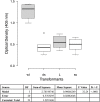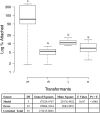Construction of Mycoplasma hyopneumoniae P97 Null Mutants
- PMID: 33967967
- PMCID: PMC8101707
- DOI: 10.3389/fmicb.2021.518791
Construction of Mycoplasma hyopneumoniae P97 Null Mutants
Abstract
Mycoplasma hyopneumoniae is the causative agent of enzootic pneumonia, a world-wide problem in the pig industry. This disease is characterized by a dry, non-productive cough, labored breathing, and pneumonia. Despite years of research, vaccines are marginally effective, and none fully protect pigs in a production environment. A better understanding of the host-pathogen interactions of the M. hyopneumoniae-pig disease, which are complex and involve both host and pathogen components, is required. Among the surface proteins involved in virulence are members of two gene families called P97 and P102. These proteins are the adhesins directing attachment of the organism to the swine respiratory epithelium. P97 is the major ciliary binding adhesin and has been studied extensively. Monoclonal antibodies that block its binding to swine cilia have contributed extensively to its characterization. In this study we use recombination to construct null mutants of P97 in M. hyopneumoniae and characterize the resulting mutants in terms of loss of protein by immunoblot using monoclonal antibodies, ability to bind purified swine cilia, and adherence to PK15 cells. Various approaches to recombination with this fastidious mycoplasma were tested including intact plasmid DNA, single-stranded DNA, and linear DNA with and without a heterologous RecA protein. Our results indicate that recombination can be used to generate site-specific mutants in M. hyopneumoniae. P97 mutants are deficient in cilia binding and PK15 cell adherence, and lack the characteristic banding pattern seen in immunoblots developed with the anti-P97 monoclonal antibody.
Keywords: Mycoplasma hyopneumoniae; P97; adherence assay; adherence protein; immunoblot; null mutant; recombination.
Copyright © 2021 Clampitt, Madsen and Minion.
Conflict of interest statement
The authors declare that the research was conducted in the absence of any commercial or financial relationships that could be construed as a potential conflict of interest.
Figures





Similar articles
-
Molecular analysis of the P97 cilium adhesin operon of Mycoplasma hyopneumoniae.Gene. 1998 Jul 3;214(1-2):13-23. doi: 10.1016/s0378-1119(98)00247-9. Gene. 1998. PMID: 9729120
-
Characterization of cleavage events in the multifunctional cilium adhesin Mhp684 (P146) reveals a mechanism by which Mycoplasma hyopneumoniae regulates surface topography.mBio. 2012 Apr 3;3(2):e00282-11. doi: 10.1128/mBio.00282-11. Print 2012. mBio. 2012. PMID: 22493032 Free PMC article.
-
Identification and characterization of a Mycoplasma hyopneumoniae adhesin.Infect Immun. 1995 Mar;63(3):1013-9. doi: 10.1128/iai.63.3.1013-1019.1995. Infect Immun. 1995. PMID: 7868222 Free PMC article.
-
Update on Mycoplasma hyopneumoniae infections in pigs: Knowledge gaps for improved disease control.Transbound Emerg Dis. 2018 May;65 Suppl 1:110-124. doi: 10.1111/tbed.12677. Epub 2017 Aug 23. Transbound Emerg Dis. 2018. PMID: 28834294 Review.
-
Mycoplasma hyopneumoniae variability: Current trends and proposed terminology for genomic classification.Transbound Emerg Dis. 2019 Sep;66(5):1840-1854. doi: 10.1111/tbed.13233. Epub 2019 Jun 4. Transbound Emerg Dis. 2019. PMID: 31099490 Review.
Cited by
-
Mycoplasma hyopneumoniae membrane protein Mhp271 interacts with host UPR protein GRP78 to facilitate infection.Mol Microbiol. 2022 Sep;118(3):208-222. doi: 10.1111/mmi.14963. Epub 2022 Jul 16. Mol Microbiol. 2022. PMID: 35791781 Free PMC article.
-
Genome Editing of Veterinary Relevant Mycoplasmas Using a CRISPR-Cas Base Editor System.Appl Environ Microbiol. 2022 Sep 13;88(17):e0099622. doi: 10.1128/aem.00996-22. Epub 2022 Aug 24. Appl Environ Microbiol. 2022. PMID: 36000854 Free PMC article.
-
Gene editing tools for mycoplasmas: references and future directions for efficient genome manipulation.Front Microbiol. 2023 May 18;14:1191812. doi: 10.3389/fmicb.2023.1191812. eCollection 2023. Front Microbiol. 2023. PMID: 37275127 Free PMC article. Review.
References
-
- Bogema D. R., Deutscher A. T., Woolley L. K., Seymour L. M., Raymond B. B., Tacchi J. L., et al. (2012). Characterization of cleavage events in the multifunctional cilium adhesin Mhp684 (P146) reveals a mechanism by which Mycoplasma hyopneumoniae regulates surface topography. mBio 3:e00282-11. - PMC - PubMed
-
- Bogema D. R., Scott N. E., Padula M., Tacchi J. L., Jenkins C., Cordwell S. J., et al. (2011). Sequence TTKF | QE defines the site of proteolytic cleavage in Mhp683 protein, a novel glycosaminoglycan and cilium adhesin of Mycoplasma hyopneumoniae. J. Biol. Chem. 286 41217–41229. 10.1074/jbc.m111.226084 - DOI - PMC - PubMed
LinkOut - more resources
Full Text Sources
Other Literature Sources

